|
The sea-floor ‘stalactite cavern’ was discovered by Mr. Youhachirou Izumi, of the Yonaguni Diving Service, and has been extensively studied by Professor Masaaki Kimura and his students at the University of the Ryukyus, Okinawa.
Professor Kimura himself has dived on the area more than 100 times over the past twenty years or so, and his students have since logged many hundreds of hours between them during that time.
As can be seen from the image below showing a diver exploring inside the cavern, the ‘stalagmite’, which obviously formed on the ground over many centuries has joined with the ‘stalactite’, which formed over a similar period from the ceiling downwards towards the stalagmite.
It is near the sea-floor by the ‘No. 1 Monument’ at Iseki Point, just off the coast of Yonaguni-jima.
Stalactite caverns are formed ‘ONLY’ on dry land, when weakly acidic rainwater or river water seeps through limestone which then dissolves and eventually drips through into the cavern.
Slowly, and over many centuries, these limestone-rich drips begin to solidify into stalagmites (on the ground) and stalactites (on the ceiling).
This is the only way that this ‘stalactite cavern’ could have been formed – and it had to have formed when the cavern was last above sea-level.
Was that 10,000 years ago as many investigators believe?. If any further proof were needed that the area around Iseki Point was once very firmly, and dryly, above sea-level this “Stalagmite Cavern” must be it.
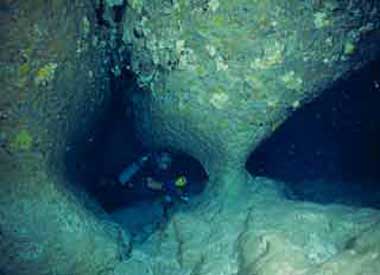
Dr. Masaaki Kimura
—
Okinawa, Japan
—
As the debate rages over whether or not the structures at Iseki Point are ‘natural’ or ‘man-made’, it is important to remember that, in ancient times, peoples all over the world seem to have utilised ‘natural rock formations’ for a wide variety of usages.
They seem to have been very practical peoples who were happy to modify what nature provided if it suited their purposes, and no better example of this could be given than the Great Sphinx on the Giza Plateau in Egypt.
Carved out of the ‘living bedrock’, the Great Sphinx is one of the few surviving structures of the archaic world – on dry land that is.
It is also important to remember that, while Boston University geologist,
Dr Robert M. Schoch – who has made a number of dives at Iseki Point in 1997 and 1999 – did indeed state afterwards that in his opinion as a geologist the ‘No.1 Monument’ was “…
primarily a natural structure …”, but it is very important to remember that he also went on to say that:
“We should also consider the possibility that the Yonaguni Monument is fundamentally a natural structure that was utilized, enhanced, and modified by humans in ancient times.”
Perhaps the images below of two sets of steps – the one on the left is on the ‘main terrace’, and the one on the right is on the ‘upper terrace’ – were the features Dr Schoch was thinking of when he made that statement.
Certainly anyone looking at them from the perspective of Professor Kimura’s photographs should be in no doubt that ‘natural erosive forces’ could never have been ‘solely’ responsible for this obvious pair of constructed stone steps or stairs that were found only yards apart on the ‘No.1 Monument’ at Iseki Point.
|
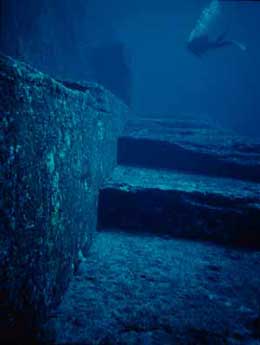
Dr. Masaaki Kimura
—
Okinawa, Japan
—
|
|
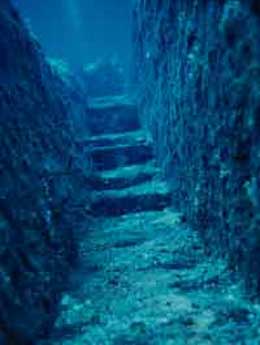
Dr. Masaaki Kimura
—
Okinawa, Japan
—
|
But of all the numerous structures found on the sea-floor around the island of Yonaguni-jima, there is one which seems to have ‘enchanted’ everyone who has had an opportunity to see it up close.
This is the enigmatic carved structure that has been called ‘the goddess rock’, and it was discovered at a depth of about 50 feet northwest off San’ninu-dai.
It is indeed a massive structure, and for the purpose of comparison we have placed an image of it next to an image of a more well-known, and similar-sized, structure with large ‘paws’ that all archaeologists and geologists seem to agree was also ‘carved out of the living bedrock’ – The Great Sphinx of Egypt.
|
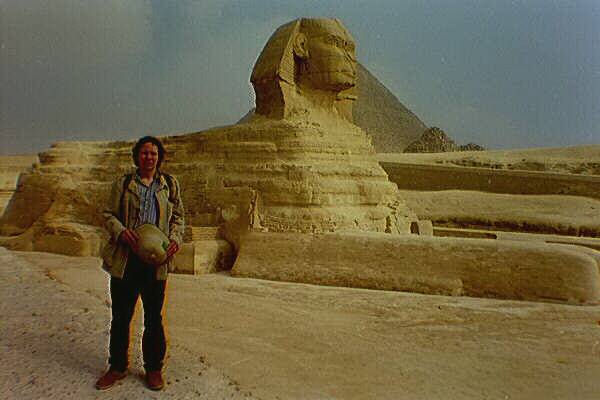
Dr. Robert Schoch
—
The Great Sphinx, Giza, Egypt
—
|
|
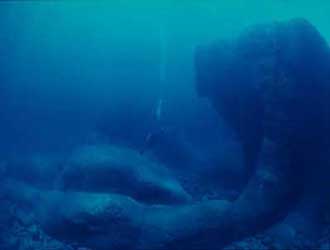
Dr. Masaaki Kimura
—
Underwater Sphinx, Yonaguni, Japan
—
|
History’s Mysteries
“Do undersea relics near Okinawa offer proof of a sophisticated civilization during the last ice age?
Archeologists have long believed that civilization as they define it — intelligent, tool-making, monument building, social humans — began about 5,000 years ago.
But submerged beneath the waves near the Japanese island of Yonaguni is evidence that may well overturn that long-held theory.
A small but persuasive number of scholars and scientists have long thought that “advanced” societies may have existed as long as 10,000 years ago.
Their theories, however well reasoned and defended, have been hamstrung by a lack of evidence.
But recent discoveries of man-made artifacts on the Pacific seafloor may well prove to be the smoking gun that will propel this alternative view of civilization to prominence”.
see the evidence with ‘unique underwater footage’
of the various Yonaguni structures in the
‘History Channel’ TV programme
“Japan’s Mysterious Pyramids”
NTSC DVD
or
VHS
|